Hello July, with your sweet, sticky air and oddly satisfying scent of sunscreen. Here we are in the slow, lazy height of summer, so what better place to visit for this Pasta of the Month than the beaches and beating sun of Sicily? On this island, dried pasta reigns supreme—especially casarecce, rigatoni, and tiny rings called annelletti—but there are a few fresh pasta exceptions. Busiate, ancient spirals from the western port city of Trapani, are one of them.
Many historians believe busiate to be the oldest handmade Sicilian pasta. Records of their existence date back over a thousand years, when Sicily prospered under Arab rule (for more on the fascinating history of Sicily, click the post linked below). In their original form, ropes of dough were coiled around a particular type of grass reed that flourished in Trapani’s sandy soil called a busa, from the Arabic word bus. (It’s also possible the name originates from the word buso, an iron knitting needle that was used in the region.) The result was a tight, slightly flattened ringlet shape reminiscent of the now-obsolete telephone cord. Today, it’s traditional to use a long, often square-shaped metal rod called a ferretto, or ferro (meaning “iron”), to achieve the same corkscrew effect.
As with most pastas from Italy’s south, busiate are made without eggs. Durum wheat flour (semolina, or semola rimacinata) and water are all you need, though it’s also common to use whole-grain flour—historically, an ancient durum wheat called tumminia that was brought to Sicily by the Greeks—a variation that I particularly love. Tumminia is high in fiber and unmistakably aromatic, with a malty, slightly sweet flavor. It’s also expensive and difficult to find (it’s available here), so grains like Einkorn and spelt are good alternatives.
As for a ferretto, you can find one in some markets in Italy, or online via q.b. cucina, where I sourced mine after years of searching. This tool isn’t just a one-trick pony: It’s also used to make rustic, tubular versions of maccheroni and fusilli typical of Basilicata and Calabria, among other fresh pastas. That said, a wooden or metal barbeque skewer, a chopstick, or a thin knitting needle from a local crafts store also work wonders, and perhaps best exemplify this pasta’s resourceful origins.
So, what to serve with busiate? The answer is uncharacteristically straightforward: pesto alla Trapanese. Of course, it’s not the only answer, but it’s the most common pairing for a reason. This pesto is light and refreshing thanks to the addition of plum tomatoes—typically the firm and flavorful pizzutello variety—making it perfect for warm weather. And, like the pasta itself, the sauce is rooted in the Trapani harbor: Many believe that Genoa’s basil pesto made its way to Sicily via Genoese merchant ships that stopped in the city on their trade routes. The recipe was then revised to feature local ingredients like almonds and tomatoes in addition to garlic, basil, and olive oil. It’s traditional to use a mortar and pestle to make Trapanese pesto, as it is with Genovese and other pestos, which is well worth the effort. The texture should be a little chunky rather than the smooth result you might get from a blender or food processor.
I love Genovese pesto (who doesn’t?), but I’m not ashamed to say I like this one more. Especially in July, when tomatoes are juicy, ripe, and the star of my every meal. A recipe for pesto alla Trapanese will be in my forthcoming cookbook, but you can find it all over the internet. And, unlike Genovese pesto, which is extremely rigid in its recipe, this one is far more flexible (example: cheese is optional, so it’s a great vegan option, too!). Of course, if you’re not a tomato person, busiate also pair well with light seafood sauces, particularly fresh tuna; I’ve even served them with puréed radish greens. Plus, I’ll be sharing a southern Italian-inspired sauce recipe in my next issue that’s definitely busiate-worthy.
So, head outside, grab a barbeque skewer, and let’s make busiate!
Busiate
Dough
400 grams (a scant 2½ cups) semolina or semola rimacinata
200 ml (¾ cup plus 4 teaspoons) warm or tepid water
Equipment
Work surface, preferably wooden (a large cutting board works great)
Metal bench scraper or sharp knife
Rolling pin (or wine bottle)
Ferretto, wooden or other barbeque skewer, chopstick, or thin knitting needle
Sheet pan or other tray for storing finished pasta
Directions
Make the dough:
Make the dough by hand or in a food processor according to the directions in this post. Let it rest, tightly covered, at room temperature for about 30 minutes.
Set up your workspace:
While the dough rests, gather your tools. Line a sheet pan or tray with parchment paper, or dust it with a thin layer of semolina.
Roll and cut the dough into strands:
Cut off a quarter of the dough and re-wrap the rest. Flatten the section of dough with the palm of your hand. Then, with a rolling pin (or wine bottle), roll the dough into a disc about ¼ inch thick. Cut the disc into ½-inch strips.
Roll each strip into a thin rope, about the thickness of an udon noodle (a little thicker than Tuscan pici). Keep any strips you’re not immediately using covered with a damp dishcloth to prevent them from drying out.
If you have a ferretto, cut the rope into about 8-inch segments; if not, cut the rope into segments slightly shorter than your skewer of choice.

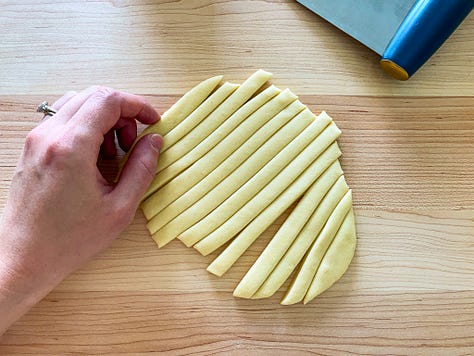

Shape the busiate:
Position a strand of pasta vertically on the board, at 12 and 6 o’clock. Place the ferretto (or other skewer) at a 45-degree angle toward the left-hand side so you have an upside-down V.
Holding the bottom of the ferretto loosely in place with your left hand, use your right hand to roll the other end—where the dough and skewer meet—toward you as if tracing an arc (the ferretto will scoot a little to the right and that’s totally fine). The pasta will naturally curl around the skewer like a telephone cord.
Once the dough is completely twisted around the skewer, position it horizontally on your work surface. Gently roll the skewer, with the pasta still attached, back and forth once or twice to flatten the dough. Twist the skewer to loosen the pasta and slide it off.
Arrange the finished busiate in a single layer on the prepared sheet pan and repeat with the remaining dough. If you have time, let the pasta dry uncovered at room temperature for an hour (or up to 5 hours) before cooking. Busiate take approximately 3 to 5 minutes to cook in salted boiling water, depending on size, thickness, and drying time.



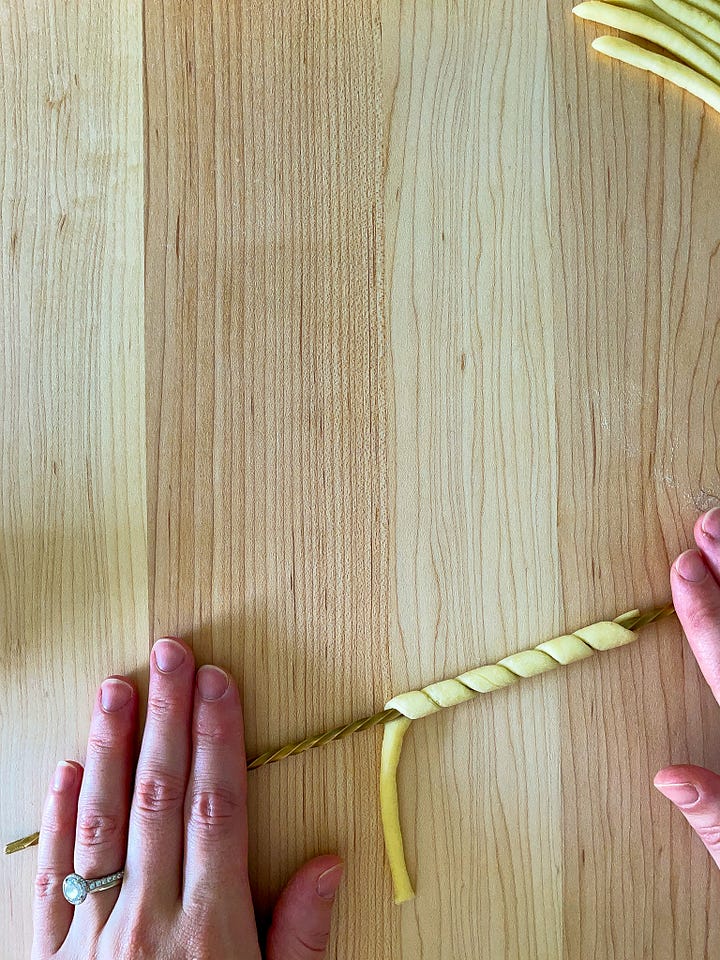
Storage
To store the pasta for future use, freeze the sheet pan with the busiate (uncovered) for about 30 minutes until the pieces are solid, then carefully transfer them to a freezer bag. When you’re ready to boil them, do so straight from frozen—no need to thaw. Note that frozen pasta, especially if partially dried first, will take an extra minute or two to cook.








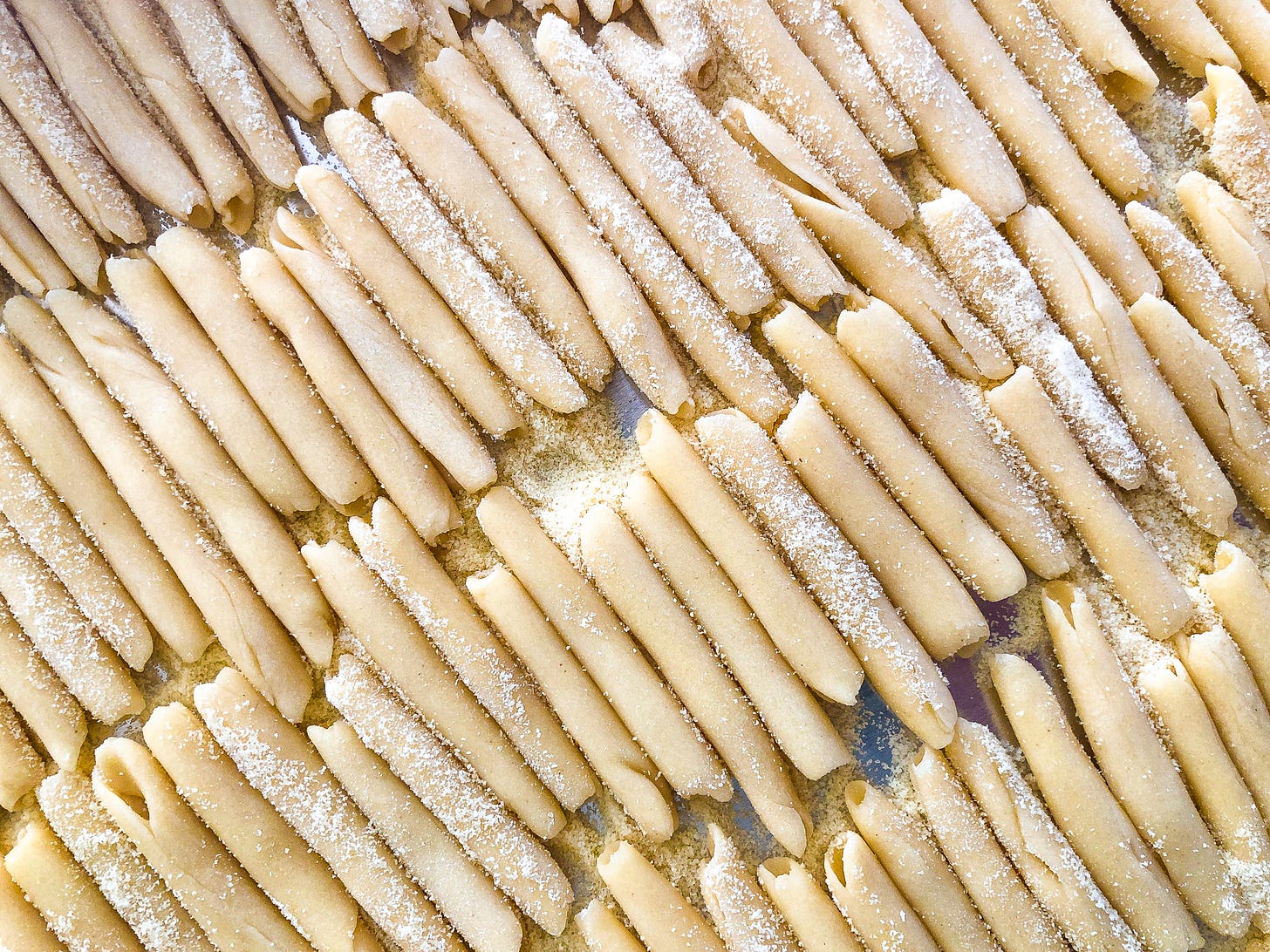
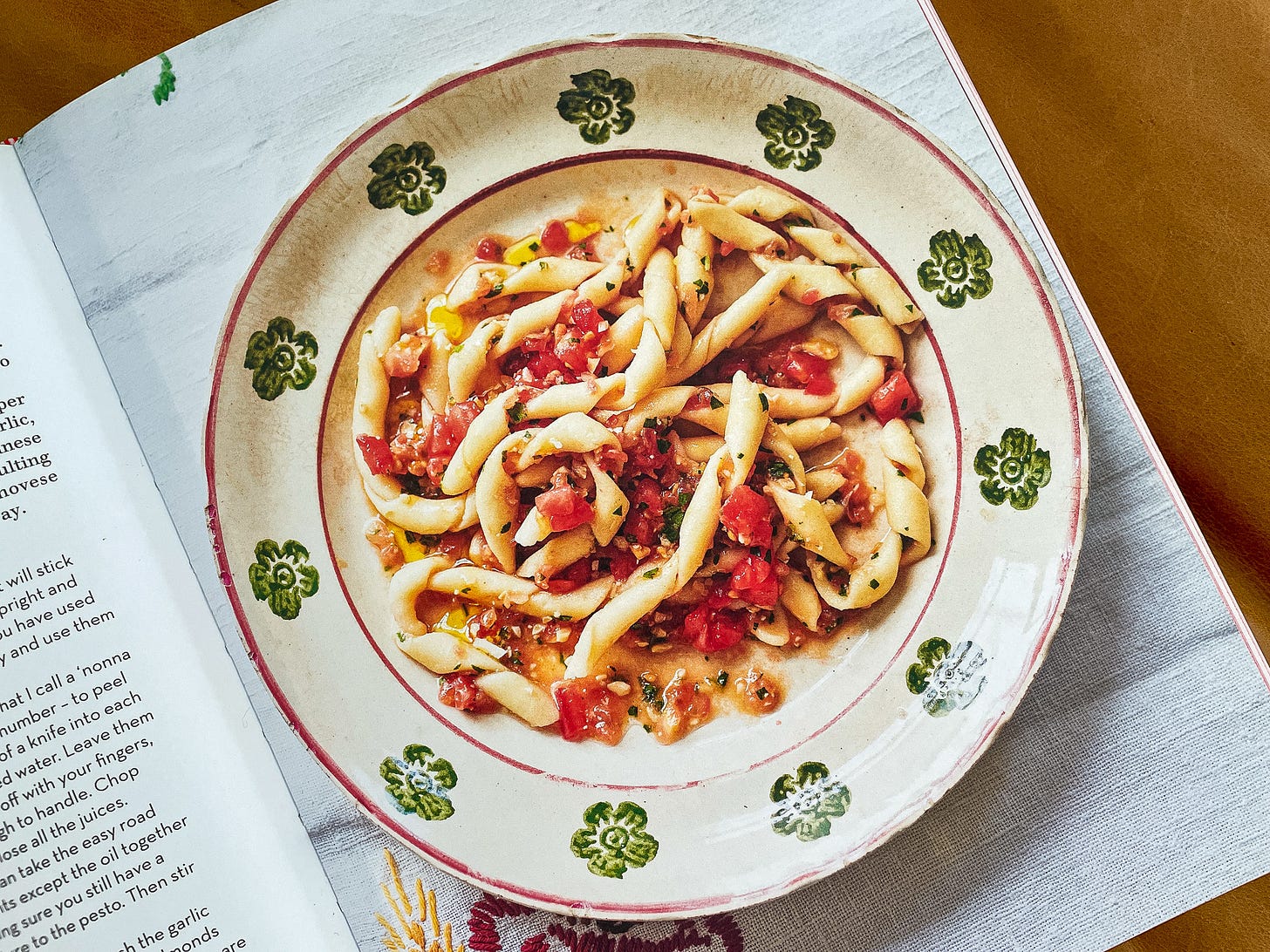

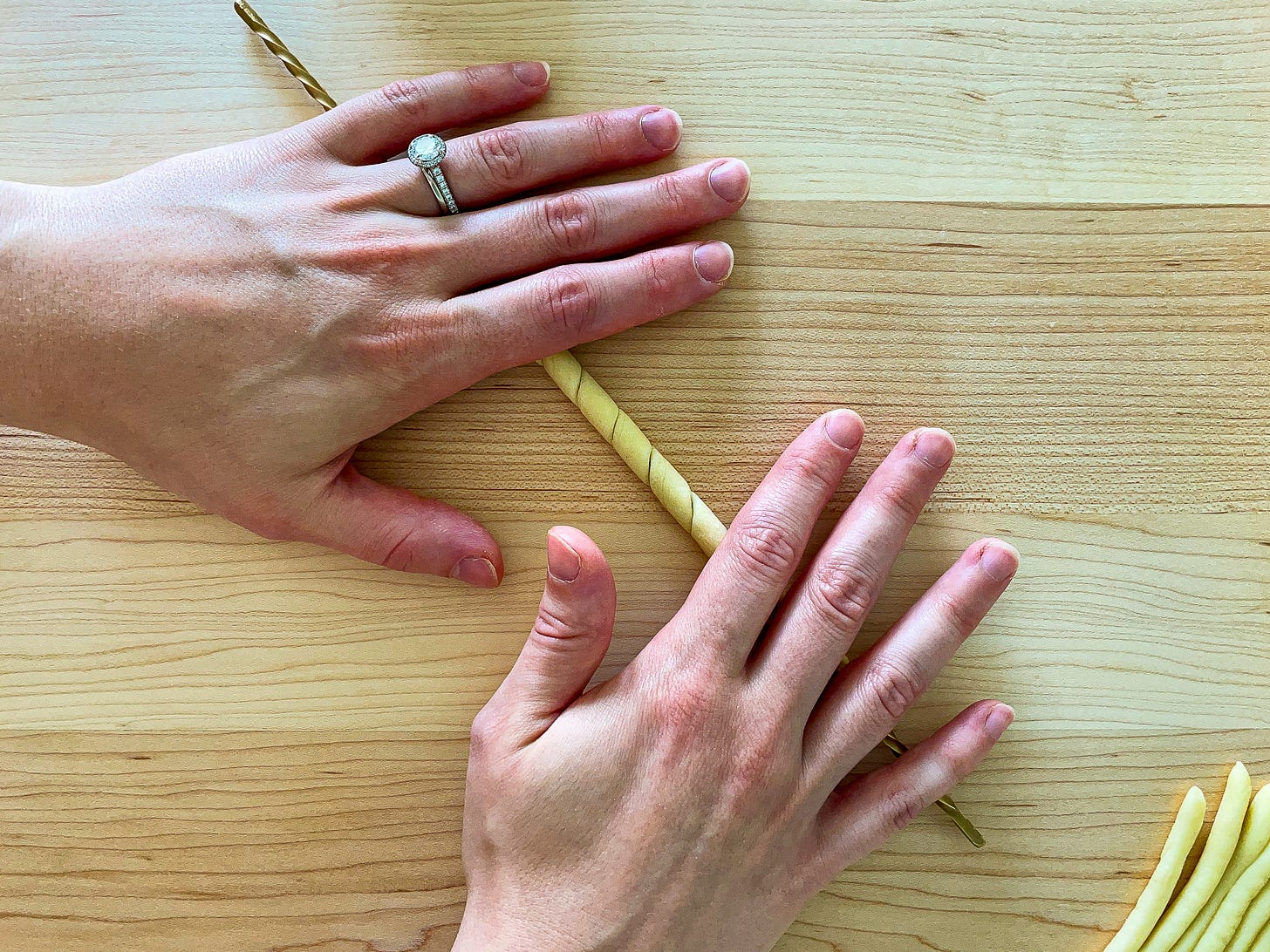
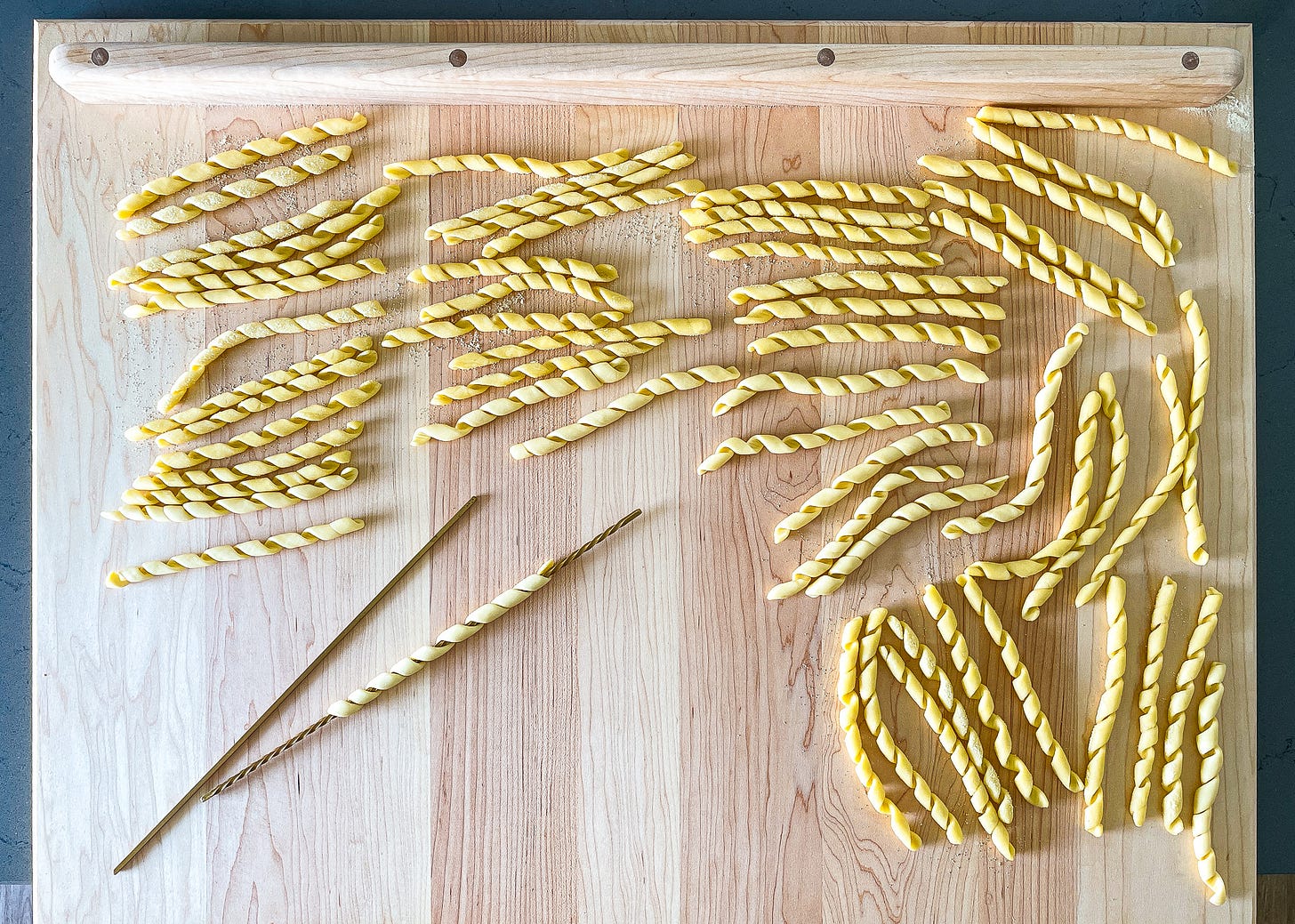
It's hard to imagine you can make this beautiful pasta with just two ingredients. So alluring, I can't wait to try it.
I made this last night, half recipe for two people, with a chopstick, starting at the narrow end so it was easy to push the coils off. It was fun to make! Served it with mint-cilantro-almond pesto. yummm. I'll make this again, soon.